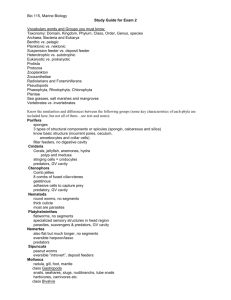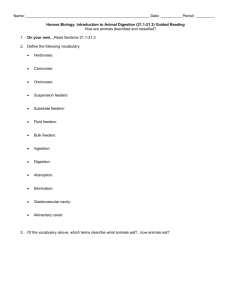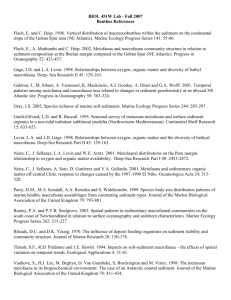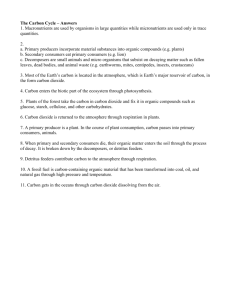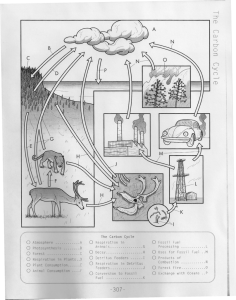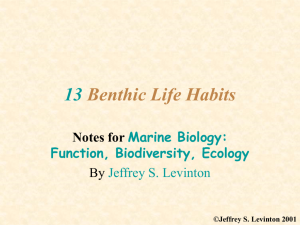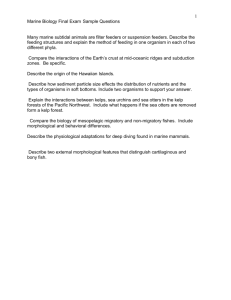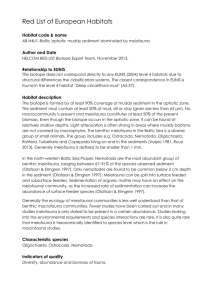Soft Substrate Communities
advertisement
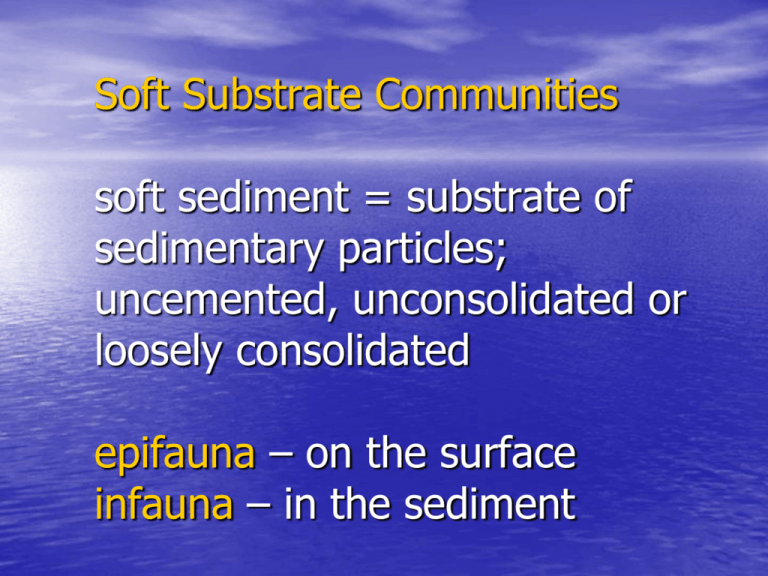
Soft Substrate Communities soft sediment = substrate of sedimentary particles; uncemented, unconsolidated or loosely consolidated epifauna – on the surface infauna – in the sediment Physical Environment 1. Grain size - particle size high energy = large grain size; sand low energy = small grain size; mud median grain size – sandy silt, silty sand sorting – range of particle sizes, biological sorting Substrate mobility – influenced by animals – burrowing, binding in tubes – cohesiveness – microbes, mucus Interstitial space – space between grains, “pores” – affects water drainage – diffusion of chemicals 2. Organic Matter - % organic matter - substrate for microbial decomposition, detritus feeders 3. Oxidation-reduction state redox potential discontinuity layer (RPD) - measured by electrode (Eh) Above RPD – oxygen present Below RPD – oxygen absent Chemosynthetic bacteria – use H2S Sulfate-reducing bacteria – produce H2S (fermentation) • Organisms affect the depth of the RPD layer in irrigated tubes, extend RPD into sediments • Organisms must adapt to anaerobic conditions – Bring oxygenated water down – Tolerate H2S 4. Light – when present, plants present - benthic diatoms - macroalgae - seagrasses Size of infaunal organisms • Macrofauna: • Meiofauna: • Microfauna: >0.5 mm 0.5-0.062 mm < 0.062 mm Clams Snails Suspension feeders Trophic Structure • Suspension Feeders (filter feeders) - primary food = plankton - generalists, size selection by filter • Deposit Feeders - animal that feeds by consuming particles in or on the substrate - “detritivore” Types of deposit feeders • Surface deposit feeders • Burrowing or deep Microbial Stripping Theory – deposit feeders don’t digest detritus, just digest microorganisms on the detritus and sediment particles Fenchel: - low assimilation efficiency detritus (1-10%) - high assimilation efficiency microbes (40-80%) Logical argument for microbial stripping • Composition of the detritus - sources, age - temporal variation • Digestion detritus vs microbes • Constancy and quality of microbes - microbial colonization - protein Renewal rates - microbes • Animal must not ingest again until microbes recolonize • pelletization Predators Physical or biological? • Soft bottom benthic communities structured by ??? • Expt evidence Physical – • Oliver 1979 – Subtidal zoned on gradient of wave energy – < 14m – regular disturbance, small molbile crustaceans – > stable, tube polychaetes Both biological and physical • Mills 1969 – sandy area, low biomass, density of IF • Illyanassa – mech disturbance by snails • Low Illyanassa density – colonization by Ampeleisca tube building amphipod – exclude Illyanassa • Selective deposit feeding produces fine sediments, tubes create topo diversity, promotes colonization by polychaetes • Winter storms, destabilize Ampelisca mats • Illyanass recruits in spring, Biological factors • Competition • direct displacement – rare ( no hard surface to push against) , no colonials • Food/space – evidence form regular spacing of individuals • interference- Levinton 1977 • Direct: Active Bivalve Yoldia limulata disrupts burrows of less mobile Solemaya velum; Illyanassa and Ampleisca Indirect : more common • Burrowing DF – muddy sand w/high [OM] • Where DF present in high no. SF absent • DF burrow, fecal material, create loose surface layers, unstable, easily resuspended • Clogs SF feeding • Buries SF larvae, DF larvae OK • Exclusion of one trophic group by another Rhoads and Young 1970 • Reworked sediments by 3 sp DF clams, Yoldia, Nucula, Macoma – excludes DF • Soft sediment animals affect the sediment they live in • Functional groups – animals that use/affect the environment in the same way – Trophic groups – Sediment stabilizers/destabilizers Types of organisms • Sediment stabilizers – Organisms that secrete mucous or otherwise bind sediment; roots – Amphipods, phoronid worms, anemones, polychaetes • Sediment destabilizers (bioturbators) – motile or sedentary organisms who cause sediments to move – Sea cucumbers, mobile clams, whelks • Deposit feeders produce fluid fecal rich surface • Easily resuspended by low velocity currents • Instability might interfere with suspension feeders: – Experiments with Mercenaria in trays above bottom – Deposit feeder larvae not affected Trophic Group Amensalism • Interaction between two trophic groups in which one group is inhibited while the other is not – Inhibitors = deposit feeders; exclude suspension feeders – Physical instability of the sediment – clogs filters, buries newly settled suspension feeder larvae/juveniles; can’t maintain life position; disturbed or eaten by deposit feeders Rhodes and Young 1971 • Molpadia oolotica – large, high density, sedentary, silt-clay mud, heads down DF • Ingest sediment at depth. Deposit loose fecal matter, form mounds • Reworking produces loose high water content easily susp. sediment • Areas between – highly unstable • Cones – stable, fecal pellets, bound material • attracts SF polychaete Euchone, other SF tube builders • SF tube builders stabilize sediment, extend downwards into substrate • Stabilize cones, prevent resuspnsion attract more tube SF • High tube density prevent settlement of large DF/ burrowers – can’t penetrate • Indirect restriction – competitive interference • Also filter out and prey on larvae of DF Coexistence is possible • SF prefer more sandy areas – firmer, easier to build sfc tubes • Sand: DF not favored, low [OM], difficult to burrow • Areas where both can live – sharp boundaries but no physical differences • Patches – removal of residents (rays, storms) • Little asexual reproduction - colonize by larval recruitment or adult immigration Woodin 1976 Suggests there are 3 major functional groups: • Mobile (burrowing) deposit feeders • Suspension feeders • Tube builders None have overlapping distributions – why? Adult-larval interactions • Deposit feeders – change nature of sediment (trophic group amensalism), feed at surface • Suspension feeders – consume larvae while filtering • Tube builders – dense assemblage creates mat that larvae can’t penetrate; feed at surface Leads to: • Strong dominance by year classes • Inhibition model of succession – multiple stable states Ilyanassa (Nassarius) – mud snail, mobile DF Ampelisca – amphipod, tube builder Sand vs Mud Role of Predation and Competition in Soft Sediment Communities • Sediments – 3D • Refuge form non-digging predators • Ability to divide resource and avoid competition Woodin – predator trophic types • Surface –, juveniles vulnerable, affect size classes., esp those with refuge in size/depth • Browsers – nippers, rob energy • Burrowers – “weasel” predators (nemerteans, Pisaster brevispinis) • Digging – excavate holes, change sediments, indiscriminate • Infaunal – burrowing nemerteans, polychaetes Large predator/disturbers Caging Results: • Virnstein 1977– crabs/epifaunal or sfc predators: change in numbers but not composition • Ambrose 1991 – infaunal – reduce infaunal populations, eat other predators, multiple layers of predators Cage results overall – removal of predators • Increase in total density • Increase in species richness • No tendency for competitive exclusion Why No Competitive Exclusion? • Reduced opportunity for interference competition Vertical distribution • Competition for food and space SF and DF • Subtidal – food abundant – detritus • SF – partition space by depth, feeding structure (callianassa) • DF – feed at different levels • Peterson 1977 – –removal of some sp from a depth level – increase in abundance of other sp at that strata – competition – Adding sp to a depth level caused emigration by others – vertical spacing and maintain density Why No Competitive Exclusion? • Reduced opportunity for interference competition • Extreme importance of adult-larval interactions Why No Competitive Exclusion? • Reduced opportunity for interference competition • Extreme importance of adult-larval interactions • Developmental plasticity of marine invertebrates • Lack of clear competitive dominant Caging Artifacts • How could these change the results? Wilson 1991 • No evidence for both predation and competition affecting benthic community structure • No evidence for a competitive dominant in any soft bottom system • Can’t fully predict effects of predation or competition • Lack knowledge of growth, life spans, trophic types, pop dynamics , esp DF • No unifying theroy of community organization for sof bottom envtsd Multiple Stable States • Long term stability – eg Molpadia • Cyclic oscillation – Mills – Illynassa – Ampelisca, biological and physical factors • Multi- year long term – Baltic - alternating states affected by variable recruitment • Pontoporeia affinis – Macoma baltica • High Pontoporeia keeps out Macoma, poor year for Pontiporea allows Macoma, keeps out Pontoporea • Predators affects r selected species • END Recruitment Dynamics • Loss of larvae in the water column • Larvae as passive particles • Larval site selection • Adult-larval interactions • Meiofauna-macrofauna interactions Meiofauna – Macrofauna Interactions (Watzin 1983) • Larval/Juvenile macrofauna are the same size meiofauna (temporary meiofauna) • Among the meiofauna are potential predators and competitors Meiofauna – Macrofauna Interactions (Watzin 1983) • Manipulations in small boxes – Increased densities of turbellarian predators – Increased densities of “other meiofauna” – potential competitors • Exposed to recruitment for one week – Macrofauna larvae avoid treatments, or lower survival of juveniles after settlement • Must survive the “meiofauna bottleneck” – escape in size Meiofauna as Food for Bottomfeeding Fishes Other Roles of Meiofauna • Meiofauna as food for deposit feeders • Meiofauna stimulate bacterial productivity – Speed break-down of detritus – Ingest bacteria – turnover – Mucus – release of DOM Conclusions • Trophic group amensalism • Disturbance • Predation • Competition • Recruitment
